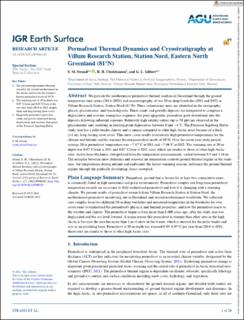Permafrost Thermal Dynamics and Cryostratigraphy at Villum Research Station, Station Nord, Eastern North Greenland (81°N)
Peer reviewed, Journal article
Published version
Permanent lenke
https://hdl.handle.net/11250/3045916Utgivelsesdato
2022Metadata
Vis full innførselSamlinger
- NGI articles [1037]
Originalversjon
Journal of Geophysical Research (JGR): Earth Surface. 2022, 127 (4), . 10.1029/2021JF006502Sammendrag
We provide the northernmost permafrost thermal analysis in Greenland through the ground temperature time series (2014–2021) and cryostratigraphy of two 20-m deep boreholes (SN1 and SN2) at Villum Research Station, Station Nord (81°N). Three sedimentary units are identified in the stratigraphy: glacial, glaciomarine, and beach deposits. These sandy and gravelly deposits are interpreted to comprise a deglaciation and isostatic emergence sequence. Ice-poor epigenetic permafrost grew downwards into the deposits following subaerial exposure. Relatively high salinity values (up to 70 ppt) are observed in the glaciomarine unit, resulting in freezing point depressions between 0 and −4°C. The Prinsesse Ingeborg Halvø study area has a polar tundra climate and is unique compared to other high Arctic areas because of a thick (>1 m), long-lasting snow cover. This snow cover results in relatively high permafrost temperatures for the climate and latitude and the warmest known permafrost north of 80°N. Over the seven-year study period, average 20 m permafrost temperature was −7.87°C at SN1 and −7.06°C at SN2. The warming rate at 20 m depth was 0.07°C/year at SN1 and 0.05°C/year at SN2, rates which are similar to those of other high Arctic sites. Active layer thickness, extrapolated from the temperature measurements, varied between 0.5 and 1.16 m. The interplay between snow dynamics and seasonal air temperature controls ground thermal regime in the study area. Air temperatures during autumn and midwinter, the fastest warming seasons, influence the ground thermal regime through the gradually developing, dense snowpack.
